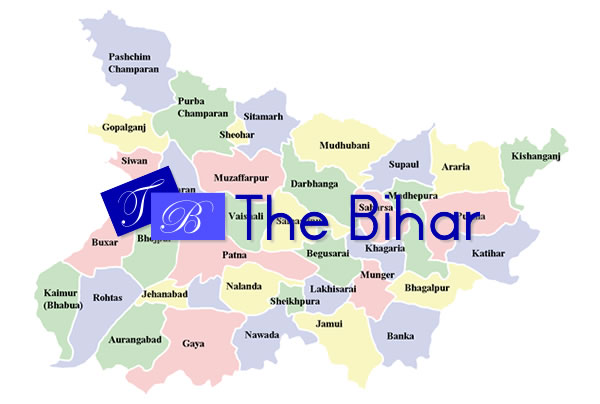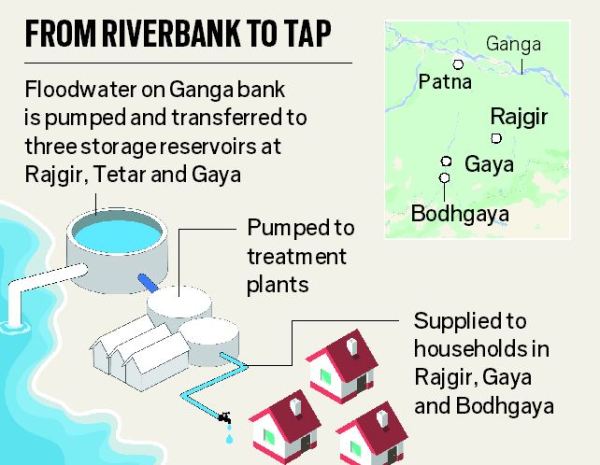Katihar
8 min readKatihar is a city and a municipality in Katihar district in the Indian state of Bihar. It is the administrative headquarters of Katihar district.
Geography
Katihar is located at 25°32’N 87°35’E25.53°N 87.58°E. It has an average elevation of 20 metres (65 feet). The main rivers of the District are mighty Ganga (southern boundary, 25 kilometers from Katihar Town), magnificent Kosi (western boundary, 30 kilometers from Katihar Town) and beautiful Mahananda besides many other small rivers like Kari Kosi (flowing by the side of Katihar town), Kamla etc. The Kosi (Sorrow of Bihar) merges with Ganga at the south-west boundary of Katihar District. This District shares boundary with two states i.e. Jharkhand at the southern side and West Bengal at the eastern side. The Bangla Desh lies around 80 km east of Katihar town and Nepal lies around 100 km north of Katihar Town. There is rail connectivity to both the borders from Katihar railway station. The hills of Jharkhand near the southern bank of Ganga is even visible from Katihar Town on a clear day. Its proximity to the Himalayas in the north, Jharkhand plateau in the south and a multiple of rivers combined with good rainfall gives it a distinct climate which can be termed more or less pleasant during most of the year. The rainy season flood is an annual feature.
Demography
As of 2001 India census[2], Katihar had a population of 175,169. Males constitute 53% of the population and females 47%. Katihar has an average literacy rate of 63%, higher than the national average of 59.5%; male literacy is 70%, and female literacy is 55%. In Katihar, 16% of the population is under 6 years of age.
History
The history of Katihar is as old as that of India. The area finds its place in the Mahabharata legend. It is said that during the period of Agyat vaas Pandavas spent its time in this area. It is also said that Lord Krishna has visited the area during Mahabharata period and had lost a mani at present Manihari (earlier Maniharan). Raja Birat of Morang also visited the place. The district has been under rule of Anga, and Magadha kings during the time of Mahajanpadas. The area was ruled by the kings of Pal dynasties. With the advent of Muslim rule in the North India Ikhtiyar-ud-din Bakhtiyr Khilazi subjugated this area and subsequently this area remaimed under indirect Mughal rule. With the strengthening of British rule Katihar came under the cluthches of Maharazas, Zamindars and Nawabs who were British Indian Agents. Till the trifurcation of Bihar, Bengal and Orissa; Katihar remained part of Bengal province and subsequently became part of Bihar Suba. With the passage of time British rule was challenged in India and Katihar was in the forefront of the agitation. With the independence of India the people of Katihar breathed free along with all the Indians. Katihar remained a subdivisional town of Purnea District for long time till it was created as an indepenedent District.
Culture and Civilization
The area was tossed between kings, Nawabs, zamindars from time to time and each rule has its impact on the district of Katihar. The town has got a cosmopolitan look. It was the main center of jute industry in Bihar which attracted workers from Mithilanchal area of Bihar, Purvanchal area of UP, Magadh region of Bihar and Bhojpuri speaking belt of Bihar and people from Nepal. The people from different region flocked to this town in search of job in jute factory, match factory and flour mills. Besides the original inhabitant of Kosi-Mahananda-Ganga Region the town witnessed an influx of permanent settlers from different region of Bihar and UP. Its proximity to Jharkhand brought many adivasis close to the town.
The partition of India had its own impact on the set up of town. Many rich Muslims either migrated to West Pakistan or East Pakistan (now Bangla Desh). But majority of Muslims chose to remain where they were. Many Hindus who came durting partition chose to settle at Katihar. The migration of Hindus continued till formation of Bangla Desh. Government of India provided them with piece of land to settle now known as Ek(1) number and Do(2) number colonies. Many Bengali Hindus settled in the town wherever they found a place. These people who were once referred as refugees in their own land because of partition has contributed significantly to the culture of Katihar.Government of India built a colony for them near Purana Jute Mill, known as Burma Colony Tingachhiya.
Guru Teg Bahadur the ninth Guru of Sikh, while returning from Assam passed through district and many local population embraced Sikhism. The famous village is Laksmipur near Karha Gola. There is a Gurudwara in the town also and there is a sizeable population of Sikhs in the town.
There is a sizeable population of Marwari and Sindhi community who are the driving force behind the economy of Katihar. Like whole of the East and North-East India they control the trading activity in Katihar. In fact in remote villages of this District one may find a Marwari doing business.
The District itself was once the part of undivided Bengal Province and there are many original Bengali inhabitants in the villages and town. In fact there is a school Ram Krishna Mission School in the town affiliated to the West Bengal Education Board.
The people here speak, Hindi, Urdu, Angika, Maithili, Bhojpuri, Bengali, Marwari, Polia, Surjapuri etc.
The town has a mix of Hindu, Muslim, Christian, Sikh and Jain religion followers.
Economy
The major source of living is agriculture. There are few industries in the town: Two jute mills and two flour mill are worth mentioning. The jute mills known as Purana Mill and Naya Mill once shaped the characteristics of town. Of late there has been lock outs, re-opening of the mills but the jute industry is in bad shape. There are units which are producing agricultural equipments in tingachhiya. The rice industry is a flourishing business in the Katihar town. The industry here is mainly agro based. One of the agro-based industry to join the group is Makhana. The Makhana Phodi (the place where edible makhana is produced from raw makhana) is growing fast. The cloth market here dealing in cotton and sarees is very vibrant and caters to nearby districts and the bordering countries of Nepal and Bangladesh. There are also a couple of old cycle trading companies with huge turnover. Pharmaceuticals business is also pretty good with huge turnover. The main crops are paddy, jute, makhana, banana, wheat and pulses. The agriculture is the mainstay of District but due to frequent floods, no proper irrigation facility and poor or no electric supply has hampered the rural area dependent upon agriculture. There is large scale migration of poor people to the various cities of India in search of job.
Communications
Katihar is a major railway station under North-East Frontier Railway. It is a very old station. In fact Katihar junction is a five (Eight if local lines taken together) line junction. 1st line goes to Barauni, 2nd line to Kolkata, 3rd line to Jogbani (Nepal border), 4th line to Guwahati, 5th line to Manihari. The other three local lines go to Purana Jute Mill, Naya Jute Mill and FCI. Katihar is also the headquarters of Katihar Railway Division. The major station under this division includes New Jalpaiguri, Siliguri, Darjeeling, Kishanganj etc. The world heritage Darjeeling Himalayan Railway falls under the jurisdiction of Katihar Railway Division. One can find trains to Nepal and Bangladesh border from here. In fact pre independence this station was connected with present day Bangladesh. All the trains passing through Katihar stops here. One can get a direct train to most of the Indian cities from this station. The notable trains are Rajdhani Express, Capital Express, Avadh Assam Express, North-East Express, Dadar Express, Amprapali Express, Sikkim Mahananda Express, Amarnath Express, Hate Bazare Express, Bangalore Express etc. Due to lack of poor road network train communication is the only source of communication.
The town does not fall on the national highway. However, NH-31 passes through the District and it is not far from Katihar Town. The road connectivity is not so good. Bus service is mostly limited to Purnea, Siliguri, Jogbani, Manihari, Bhagalpur etc. The nearest commercial airport is Bagdogra (190 km). There is an old time airstrip in the town which is mostly used as a helipad. The place is known as Hawai Adda.
Katihar is a Telecom District headed by General Manager Telecom, BSNL which covers the areas of Purnea, Kishanganj, Fobesganj, Araria, etc. Airtel,Aircel, RTL, Tata, Reliance Infocomm, RIM, Vodafone, Virgin are the other private players giving telecom services. The teledensity is low especially in rural area which reflects the economic backwardness of the rural area.
Education
There are many colleges and schools in the town. The notables are as follows:
- M.B.T.A Islamia High school
- D. S. College
- K. B. Jha College
- Mahila College
- Sur Tulsi College
- Sita Ram Chamariya College
- R. D. S. College, Salmari
- Kendriye Vidyalaya
- Netaji Vidya Mandir, O.T.Para
- Maheshwari Academy (estd. 1917)
- Marwari Pathshala
- Zila School
- Hari Shankar Nayak High School
- Children’s Happy Home
- Adarsh Vidyalaya
- Girls School
- RK Mission School (West Bengal Education Board)
- Adhin Ajab Lal Manjhi Children’s Academy
- Scottish Public School
- Madhya Vidyalaya Tingachhiya
- Ram Kanthoo School
- Colonels Academy
- A.L.High School, Sonaili
- Salmari High School
- R.K. High School, Azamnagar
- Dharmpur Ghandhi Hign School, Krishna Nager(Katihar)
- Rajyekiy Madhe Vidyala, Khaira
- Kanya Pathsala, Salempur
- Bubhna Middle School Sonaili, Katihar
- Majheli Middle School Pranpur, Katihar
- Pahlagarh Middle School Sonaili, Katihar.
- M.B.T.A.Islamia High School,Katihar
- Durga Prasad High School, Durgaganj
- Kumhari Kanya Madhya Vidyalaya, Kumhari
- Kurum middle school
- Sudhani Hight school
- Salmari High school
- Mahinagar High school
- Balia Belown High school
- Swami Vivekanand Shikshan Sansthan, Shanti Vihar, Kumhari
- Katihar High School
- Gandhi High School
- Katihar Medical College and Hospital Katihar
- Maharshi Mehi Homepathic Medical College
- I.T.I.
- Jute Research Station, Tingachhia
- O.T. Para, Rly Colony
Mandirs
The noteable temples are the Kali Temple (Kalibari), Durga Temple (Durgasthan), Shitla Temple (Burra Bazaar) & shiv Temple (Shiv Mandir Chowk).
Duraga Asthan in katihar is a very holy place for hindus living around katihar.A lot of devotees come to worship. In Durga pooja, a 10 day festival, around 1500 temporary shops and more then 150000 devotees come to have a holy blessing. Woman come there for “Khoncha Bharai” raasm.
Beside there is a Mangal Karyalaya for marriage ceremony of middle class people.
Masjids
There are two notable landmarks such as the JAMA MASJID, located in mangal bazar and also known as KANCH MASJID, and the RAMPARA BADI MASJID, located in the mohalla Rampara.
Theatres
There are four cinema halls including the Shyama Talkies, the Prakash Talkies, the Hardayal Talkies, & the Vasant Talkies.


